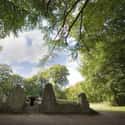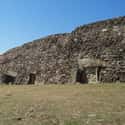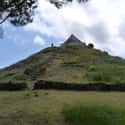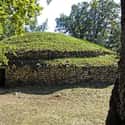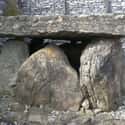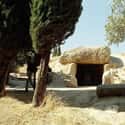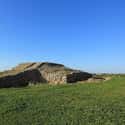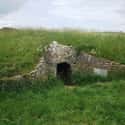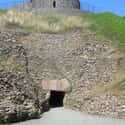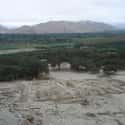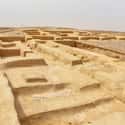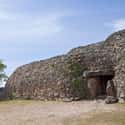-
(#1) Wayland's Smithy (c. 4th Millennium BC) - England
It makes sense that Wayland's Smithy, one of England's oldest standing structures, is located along the Ridgeway, its oldest existing road. Measuring 85 miles from Overton Hill to Ivinghoe Beacon, the Ridgeway is roughly 5,000 years old and dates back to the Bronze Age.
As for Wayland's Smithy itself, the Neolithic long barrow was constructed around 3400 BC (though it was built atop an older structure that dates to approximately 3500 BC). The Saxons believed it was the home of Wayland, a legendary blacksmith in Scandinavian, Germanic, and Anglo-Saxon mythology.
-
(#2) The Cairn Of Barnenez (c. 4800 BC) - France
The Cairn de Barnenez predates the Great Pyramid of Giza by about 2,000 years and is the "largest megalithic mausoleum" in Europe. That's a fancy way of saying it's a burial chamber made of stone.
The cairn contains 11 passage tombs, where pottery shards, stone axes, and other artifacts have been discovered - some of which date as far back as the Stone Age.
-
(#3) The St. Michel Grave Mound (c. 5th Millennium BC) - France
Located near Carnac, a town in northwestern France, the Tumulus - or grave mound - of St. Michel is the largest such grave mound on the European continent.
The mound's exact date of construction has been difficult to pin down, but it's believed to have been built sometime in the fifth millennium BC. The chapel seen atop the mound is a relatively new addition.
-
(#4) The Necropolis Of Bougon (c. 5th Millennium BC) - France
As its name suggests, the Necropolis of Bougon is not a single structure but several barrows that date back to the Stone Age. Located in western France, the five barrows span a broad range of years from around 4700 to 3500 BC. Some 220 human remains have been unearthed here, along with several Neolithic artifacts.
The necropolis is open to the public, and a museum providing further information about the site is located not far away.
-
(#5) Listoghil (c. 4300-3500 BC) - Ireland
Located in Ireland's Sligo County, Listoghil is the central structure within the prehistoric tombs of Carrowmore. Carrowmore contains 30 stone monuments, some in the form of boulder circles and others in more sophisticated dolmens.
Listoghil was excavated in the late 1990s, but its chamber was looted in the mid-19th century. DNA evidence suggests that older male leaders were buried here and in neighboring chambers.
-
(#6) The Dolmen Of Menga (c. 3750-3650 BC) - Spain
The Menga Dolmen is one of three burial chambers located in Spain's Andalusia region dating back to the Neolithic and Bronze Age. As UNESCO describes the site, "These three tombs, buried beneath their original earth tumuli, are one of the most remarkable architectural works of European prehistory and one of the most important examples of European Megalithism."
The Menga Dolmen is the largest example of a massive, prehistoric tomb structure in Europe, though all three are significant not only for their size but also for their completeness. During the summer solstice, the rising sun shines right through the dolmen's entrance corridor, evidence that the structure probably held some ceremonial or ritualistic importance.
-
(#7) Monte d'Accoddi (c. 4th Millennium BC) - Italy
Among the many ancient ruins to be found in the Mediterranean region, Monte D’Accoddi stands out for its stepped pyramid structure. Constructed by Sardinia's ancient Ozieri culture more than 6,000 years ago, the temple or altar is believed to have been used for rituals.
Occupied from the late Stone Age and through the Bronze Age, the ruins have been described by Professor Maria Grazia Melis as "probably the most comprehensive representation of prehistory in Sardinia."
-
(#8) The West Kennet Long Barrow (c. 3650 BC) - England
Comprised of a core of sarsen stones and capped by chalk rubble from surrounding quarries, the West Kennet Long Barrow stretches 82 feet wide and reaches a maximum height of 10.5 feet. Originally built around 3650 BC, the tomb was used for some 1,000 years before being filled in with earth and debris.
Though first excavated in the mid-1800s, it wasn't until 1955 that the site was given a proper scientific exploration. Within the barrow's multi-chambered interior, the partial remains of 46 men and women were discovered, along with many of their possessions - all dating to the era between 3000-2600 BC.
-
(#9) The Knap Of Howar (c. 3700-3500 BC) - Scotland
Located on the island of Papa Westray in Scotland's Orkney archipelago, the Knap of Howar has been called "the heart of Neolithic Orkney," and is an extremely well preserved late Stone Age farmstead. The site consists of two houses built some 5,000 years ago, where various tools, animal remains, and evidence of an agricultural economy have been found.
-
(#10) The Ġgantija Temples (c. 4th Millennium BC) - Malta
Ġgantija derives from the Maltese word for "giant," and the title is certainly apt. Some of the limestone blocks used in this monument weigh more than 50 tons. Consisting of two temples enclosed by a single boundary wall, the inner structures contain doorways, altars, several apses, and may have once featured plaster and paintings on the walls.
The "best preserved of all the Maltese temples," Ġgantija dates back to the Neolithic, or late Stone Age. For many years, the temple was believed to be the oldest free-standing archaeological monument on Earth, though it was later supplanted by Göbekli Tepe in Turkey.
-
(#11) Stoney Littleton Long Barrow (c. 3500 BC) - England
It is likely that the land surrounding the Stoney Littleton barrow has been used as farmland since at least the late Stone Age. The barrow is about 100 feet long and contains multiple chambers where human remains were interred. It has been dated to around 3500 BC, thought it may have been constructed even earlier.
In terms of the barrow's significance, English Heritage notes, "They seem to represent the emergence of élites among the early farming communities – élites whose status may have led them to develop ideas about ancestry and posterity that required impressive and durable structures for their expression."
-
(#12) La Hougue Bie (c. 3500 BC) - Jersey
La Hougue Bie derives its name from the Norse language, and essentially means "the homestead near the mound." The site dates back nearly 6,000 years ago, to Jersey's Stone Age past, and was likely used for various ceremonies and rituals. The tomb was constructed in such a way that the rising sun illuminates the interior on the spring and autumn equinox.
“We know there were rituals associated with seasonal activities because the Neolithic people were the first farmers," archaeologist Olga Finch told the BBC.
-
(#13) Sechin Bajo (c. 4th Millennium BC) - Peru
One of the more recent discoveries on this list, Sechin Bajo was unearthed in Casma, Peru, in 2008. It is a ceremonial plaza that was built about 5,500 years ago, making it "one of the oldest structures ever found in the Americas," according to archaeologists.
One archaeologist, German Yenque, told Reuters that architecture beneath the plaza itself may date back even earlier. “There are four or five plazas deeper down, which means the structure was rebuilt several times, perhaps every 100 to 300 years.”
-
(#14) Shahr-e Sukhteh (c. 3200 BC) - Iran
Shahr-i Sokhta means "Burnt City," and it was established at the crossroads of trading routes that existed during the Bronze Age. According to the UNESCO World Heritage Convention, "The remains of the mudbrick city represent the emergence of the first complex societies in eastern Iran."
The site likely dates back to 3200 BC, and over time it developed distinct areas for monuments, housing, burial, and manufacturing. It is believed that climate change contributed to its abandonment in the second millennium BC.
-
(#15) The Gavrinis Tomb (c. 3500 BC) - France
Today, the island of Gavrinis is uninhabited, but 5,500 years ago it was the site of a major building project that has stood the test of time. The Brittany Tourism website has a great breakdown of the specifics:
The structure is a tumulus (earth mound) covering a cairn (stone mound) covering a dolmen (stone burial chamber), which was built around 3500BC and has a diameter of 164ft (50m). To reach the burial chamber visitors must walk down a low, narrow 46ft (14m)-long passage whose walls are decorated with carved patterns and symbols such as axe heads, horned animals and swirls. At Winter Solstice, the sun shines down the passage and hits the back wall.
New Random Displays Display All By Ranking
About This Tool
There are some architects of ancient buildings who seem to have mastered the secret of eternity, making these old buildings survive for thousands of years till today. When it comes to ancient historical buildings in the world, people may think of the tomb of Qin Shihuang, the Great Wall, pyramids, etc., but they all are very young when compared with the truly oldest buildings.
Although some ancient buildings cannot be restored to their original condition, they still stand today and have precious historical and archaeological value. Here are random 15 of the oldest surviving buildings in the world, they are the witnesses of ancient human civilizations.
Our data comes from Ranker, If you want to participate in the ranking of items displayed on this page, please click here.











